Jeff Donahue
Flamingo: a Visual Language Model for Few-Shot Learning
Apr 29, 2022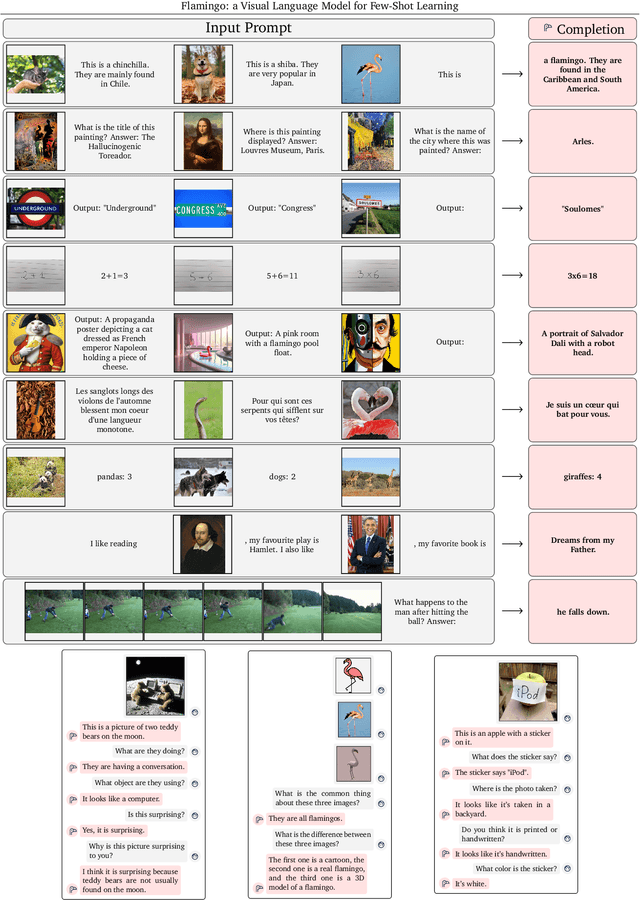

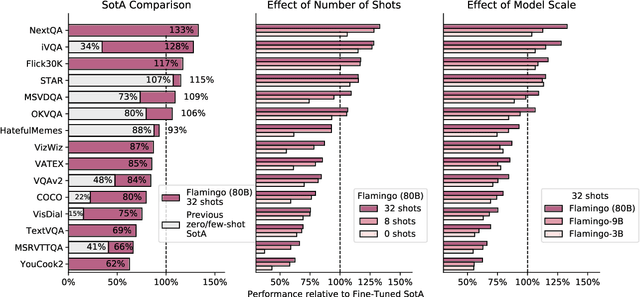
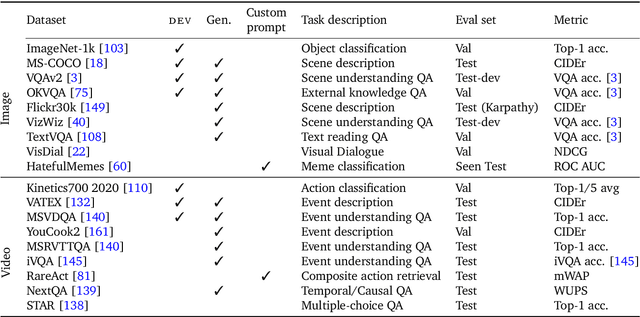
Abstract:Building models that can be rapidly adapted to numerous tasks using only a handful of annotated examples is an open challenge for multimodal machine learning research. We introduce Flamingo, a family of Visual Language Models (VLM) with this ability. Flamingo models include key architectural innovations to: (i) bridge powerful pretrained vision-only and language-only models, (ii) handle sequences of arbitrarily interleaved visual and textual data, and (iii) seamlessly ingest images or videos as inputs. Thanks to their flexibility, Flamingo models can be trained on large-scale multimodal web corpora containing arbitrarily interleaved text and images, which is key to endow them with in-context few-shot learning capabilities. We perform a thorough evaluation of the proposed Flamingo models, exploring and measuring their ability to rapidly adapt to a variety of image and video understanding benchmarks. These include open-ended tasks such as visual question-answering, where the model is prompted with a question which it has to answer, captioning tasks, which evaluate the ability to describe a scene or an event, and close-ended tasks such as multiple choice visual question-answering. For tasks lying anywhere on this spectrum, we demonstrate that a single Flamingo model can achieve a new state of the art for few-shot learning, simply by prompting the model with task-specific examples. On many of these benchmarks, Flamingo actually surpasses the performance of models that are fine-tuned on thousands of times more task-specific data.
Training Generative Adversarial Networks by Solving Ordinary Differential Equations
Oct 28, 2020



Abstract:The instability of Generative Adversarial Network (GAN) training has frequently been attributed to gradient descent. Consequently, recent methods have aimed to tailor the models and training procedures to stabilise the discrete updates. In contrast, we study the continuous-time dynamics induced by GAN training. Both theory and toy experiments suggest that these dynamics are in fact surprisingly stable. From this perspective, we hypothesise that instabilities in training GANs arise from the integration error in discretising the continuous dynamics. We experimentally verify that well-known ODE solvers (such as Runge-Kutta) can stabilise training - when combined with a regulariser that controls the integration error. Our approach represents a radical departure from previous methods which typically use adaptive optimisation and stabilisation techniques that constrain the functional space (e.g. Spectral Normalisation). Evaluation on CIFAR-10 and ImageNet shows that our method outperforms several strong baselines, demonstrating its efficacy.
End-to-End Adversarial Text-to-Speech
Jun 05, 2020



Abstract:Modern text-to-speech synthesis pipelines typically involve multiple processing stages, each of which is designed or learnt independently from the rest. In this work, we take on the challenging task of learning to synthesise speech from normalised text or phonemes in an end-to-end manner, resulting in models which operate directly on character or phoneme input sequences and produce raw speech audio outputs. Our proposed generator is feed-forward and thus efficient for both training and inference, using a differentiable monotonic interpolation scheme to predict the duration of each input token. It learns to produce high fidelity audio through a combination of adversarial feedback and prediction losses constraining the generated audio to roughly match the ground truth in terms of its total duration and mel-spectrogram. To allow the model to capture temporal variation in the generated audio, we employ soft dynamic time warping in the spectrogram-based prediction loss. The resulting model achieves a mean opinion score exceeding 4 on a 5 point scale, which is comparable to the state-of-the-art models relying on multi-stage training and additional supervision.
LOGAN: Latent Optimisation for Generative Adversarial Networks
Dec 02, 2019



Abstract:Training generative adversarial networks requires balancing of delicate adversarial dynamics. Even with careful tuning, training may diverge or end up in a bad equilibrium with dropped modes. In this work, we introduce a new form of latent optimisation inspired by the CS-GAN and show that it improves adversarial dynamics by enhancing interactions between the discriminator and the generator. We develop supporting theoretical analysis from the perspectives of differentiable games and stochastic approximation. Our experiments demonstrate that latent optimisation can significantly improve GAN training, obtaining state-of-the-art performance for the ImageNet (128 x 128) dataset. Our model achieves an Inception Score (IS) of 148 and an Fr\'echet Inception Distance (FID) of 3.4, an improvement of 17% and 32% in IS and FID respectively, compared with the baseline BigGAN-deep model with the same architecture and number of parameters.
High Fidelity Speech Synthesis with Adversarial Networks
Sep 26, 2019



Abstract:Generative adversarial networks have seen rapid development in recent years and have led to remarkable improvements in generative modelling of images. However, their application in the audio domain has received limited attention, and autoregressive models, such as WaveNet, remain the state of the art in generative modelling of audio signals such as human speech. To address this paucity, we introduce GAN-TTS, a Generative Adversarial Network for Text-to-Speech. Our architecture is composed of a conditional feed-forward generator producing raw speech audio, and an ensemble of discriminators which operate on random windows of different sizes. The discriminators analyse the audio both in terms of general realism, as well as how well the audio corresponds to the utterance that should be pronounced. To measure the performance of GAN-TTS, we employ both subjective human evaluation (MOS - Mean Opinion Score), as well as novel quantitative metrics (Fr\'echet DeepSpeech Distance and Kernel DeepSpeech Distance), which we find to be well correlated with MOS. We show that GAN-TTS is capable of generating high-fidelity speech with naturalness comparable to the state-of-the-art models, and unlike autoregressive models, it is highly parallelisable thanks to an efficient feed-forward generator. Listen to GAN-TTS reading this abstract at https://storage.googleapis.com/deepmind-media/research/abstract.wav.
Efficient Video Generation on Complex Datasets
Jul 15, 2019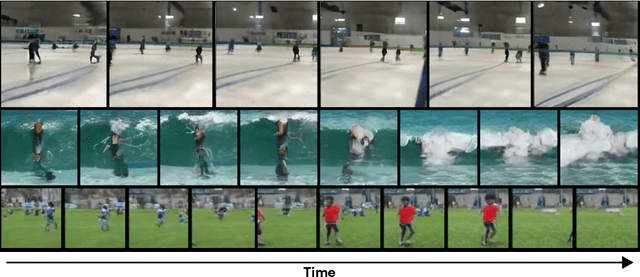


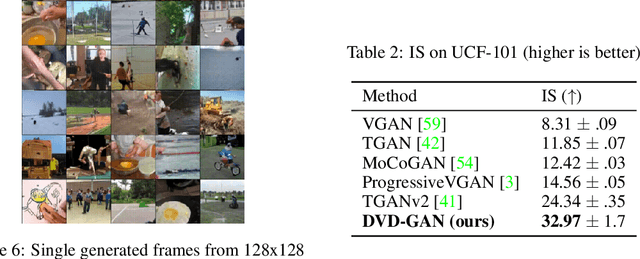
Abstract:Generative models of natural images have progressed towards high fidelity samples by the strong leveraging of scale. We attempt to carry this success to the field of video modeling by showing that large Generative Adversarial Networks trained on the complex Kinetics-600 dataset are able to produce video samples of substantially higher complexity than previous work. Our proposed network, Dual Video Discriminator GAN (DVD-GAN), scales to longer and higher resolution videos by leveraging a computationally efficient decomposition of its discriminator. We evaluate on the related tasks of video synthesis and video prediction, and achieve new state of the art Frechet Inception Distance on prediction for Kinetics-600, as well as state of the art Inception Score for synthesis on the UCF-101 dataset, alongside establishing a number of strong baselines on Kinetics-600.
Large Scale Adversarial Representation Learning
Jul 04, 2019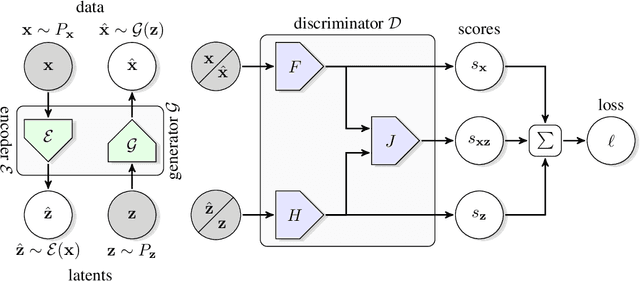
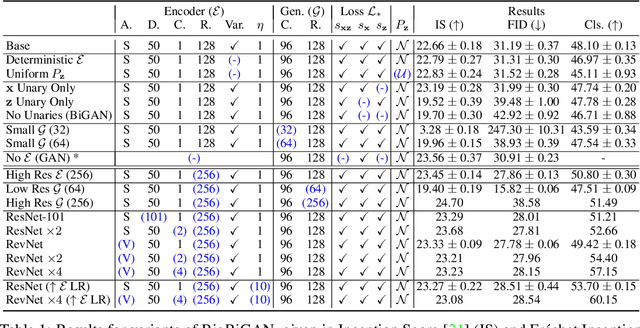


Abstract:Adversarially trained generative models (GANs) have recently achieved compelling image synthesis results. But despite early successes in using GANs for unsupervised representation learning, they have since been superseded by approaches based on self-supervision. In this work we show that progress in image generation quality translates to substantially improved representation learning performance. Our approach, BigBiGAN, builds upon the state-of-the-art BigGAN model, extending it to representation learning by adding an encoder and modifying the discriminator. We extensively evaluate the representation learning and generation capabilities of these BigBiGAN models, demonstrating that these generation-based models achieve the state of the art in unsupervised representation learning on ImageNet, as well as in unconditional image generation.
Large Scale GAN Training for High Fidelity Natural Image Synthesis
Sep 28, 2018



Abstract:Despite recent progress in generative image modeling, successfully generating high-resolution, diverse samples from complex datasets such as ImageNet remains an elusive goal. To this end, we train Generative Adversarial Networks at the largest scale yet attempted, and study the instabilities specific to such scale. We find that applying orthogonal regularization to the generator renders it amenable to a simple "truncation trick", allowing fine control over the trade-off between sample fidelity and variety by truncating the latent space. Our modifications lead to models which set the new state of the art in class-conditional image synthesis. When trained on ImageNet at 128x128 resolution, our models (BigGANs) achieve an Inception Score (IS) of 166.3 and Frechet Inception Distance (FID) of 9.6, improving over the previous best IS of 52.52 and FID of 18.65.
Population Based Training of Neural Networks
Nov 28, 2017



Abstract:Neural networks dominate the modern machine learning landscape, but their training and success still suffer from sensitivity to empirical choices of hyperparameters such as model architecture, loss function, and optimisation algorithm. In this work we present \emph{Population Based Training (PBT)}, a simple asynchronous optimisation algorithm which effectively utilises a fixed computational budget to jointly optimise a population of models and their hyperparameters to maximise performance. Importantly, PBT discovers a schedule of hyperparameter settings rather than following the generally sub-optimal strategy of trying to find a single fixed set to use for the whole course of training. With just a small modification to a typical distributed hyperparameter training framework, our method allows robust and reliable training of models. We demonstrate the effectiveness of PBT on deep reinforcement learning problems, showing faster wall-clock convergence and higher final performance of agents by optimising over a suite of hyperparameters. In addition, we show the same method can be applied to supervised learning for machine translation, where PBT is used to maximise the BLEU score directly, and also to training of Generative Adversarial Networks to maximise the Inception score of generated images. In all cases PBT results in the automatic discovery of hyperparameter schedules and model selection which results in stable training and better final performance.
Adversarial Feature Learning
Apr 03, 2017



Abstract:The ability of the Generative Adversarial Networks (GANs) framework to learn generative models mapping from simple latent distributions to arbitrarily complex data distributions has been demonstrated empirically, with compelling results showing that the latent space of such generators captures semantic variation in the data distribution. Intuitively, models trained to predict these semantic latent representations given data may serve as useful feature representations for auxiliary problems where semantics are relevant. However, in their existing form, GANs have no means of learning the inverse mapping -- projecting data back into the latent space. We propose Bidirectional Generative Adversarial Networks (BiGANs) as a means of learning this inverse mapping, and demonstrate that the resulting learned feature representation is useful for auxiliary supervised discrimination tasks, competitive with contemporary approaches to unsupervised and self-supervised feature learning.
 Add to Chrome
Add to Chrome Add to Firefox
Add to Firefox Add to Edge
Add to Edge